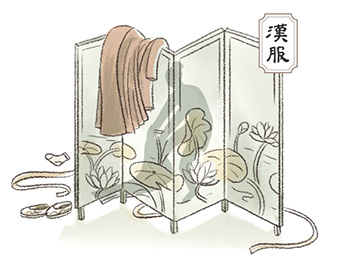
The history and revival of ancient Chinese hanfu
The wearing of ancient Chinese clothing, known as hanfu, has gone
rapidly from a niche hobby to a nationwide phenomenon in recent
years. According to a report in 2022, the hanfu market in mainland
China boasted an impressive 10.2 million customers. The same report
revealed the top three reasons consumers choose to wear hanfu: their
appreciation and love of traditional Chinese culture, the way its
style fits their aesthetics, and the fact hanfu lends itself well to
flattering photos to post on social media.
This is the first of two visual explainers about this fashion
trend.
Occasions where hanfu enthusiasts wear the traditional outfits
Day-to-day use
Grocery shopping,
commuting,
meeting friends
Hanfu gatherings
An opportunity to connect people who share a passion for
hanfu
Travel, photo taking
Traditional
Chinese
festivals
Special occasions
like weddings
What is hanfu?
Hanfu (漢服) literally means Chinese Han people’s clothing. It is a term used to describe the traditional clothes worn by the Han people.
Hanfu (漢服) or Huafu (華服) ?
There is dispute over the term hanfu (漢服), as some scholars prefer Huafu (華服); “Hua”(華) represents the Chinese nation, including all 56 of its ethnic groups. However, since Han Chinese are the dominant ethnic group in China, people generally refer to ancient Chinese clothing as hanfu.
There is also an on-going controversy over whether hanfu is the origin of hanbok, the traditional Korean costume. When a performer at the 2022 Beijing Winter Olympics opening ceremony was spotted wearing hanbok while carrying the Chinese national flag, the Koreans accused China of claiming hanbok as its own. The Chinese embassy in Seoul responded that: “These traditional cultures belong to both the peninsula and the Korean people of China, and claims of … cultural appropriation are totally untenable.”
The differences between hanfu, hanbok and the kimono
To the untrained eye, hanfu, the Japanese kimono and the Korean hanbok may look alike. However, each has distinctive design elements, historical origins, and cultural significance unique to their respective countries. Here are some of the unique features of the three types of attire.
Ancient Chinese clothing was ultra lightweight
There is a common misconception that ancient Chinese clothing was bulky and heavy. While some garments were indeed elaborate and layered, many traditional clothes, especially those made of silk, were designed to be lightweight and comfortable.
Making of silk cloth in ancient China
Hanfu basic layering system
Putting on hanfu with proper decorum was important in ancient Chinese society, as it was a way to distinguish social roles. Rules on how to wear, fold, and tie garments were followed meticulously to project an image of grace, modesty, and respect. Today, some of the followers of the hanfu revival movement adopt the same principles.
We pick some of the most common hanfu looks, both traditional and contemporary.
Associate Creative Director Marcelo Duhalde
Edited by Kevin Kwong, Paul Buck
Web Development by
Yan Jing Tian, Dennis Wong
Additional research by
Han Huang
Sources: Hanfu Hong Kong, Palace museum, National Museum of History of Taiwan, China National Silk Museum, Hanyangling Museum, Gansu Provincial Museum, Jining Museum, Ancient Chinese Clothing Research by Shen Congwen, History of Chinese apparel by Shen Congwen, Seven thousand years of Chinese costumes by Tsinghua University Press, The quintessence of Chinese culture–costume by the China Pictorial Press, The beauty of Chinese makeup by Hunan Fine Arts Publishing House, Southern Song Dynasty Huang Sheng’s Tomb in Fuzhou by the Fujian Museum, Climate change in Chinese history by Liu Zhaoming, Chinese costume restoration team, Research report on current situation of Chinese Hanfu industry and consumer behaviour 2022-2023 by iiMedia Report, White Paper on the Development of China’s New Hanfu Industry 2022 by iResearch, Baidu map